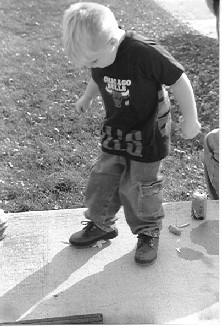

Sometimes I wish I were a potato.
Does it really matter what you build your shooter out of? I've heard that PVC is more brittle than ABS. I've heard that when PVC would shatter into thousands of small pieces, ABS would just tear. I have, however, been nearly missed by a large piece of ABS that was "torn" from a potato gun. So I don't think it really matters, it all depends if you'd rather be hit with many small pieces of PVC or one large chunk of ABS. I kind of like ABS 'cause it's black and I think that makes it better. I actually have a shooter that has both PVC and ABS parts. Originally it was all ABS but over the days parts have exploded and been replaced with anything I could find lying around. So then, what kind of glue do you use on a hybrid of both? well I think that PVC cement does in fact hold ABS better than ABS cement holds PVC. Of course if your shooter is made of only one material, you should use that kind of cement.
One thing you can be certain of is size: bigger is ALWAYS better! Well, that's my thought anyway. Generally the bigger the gun, the bigger the bang and the fun. I once made a shooter from scraps lying around that was small enough to shoot a grape, but how much fun is that? I would prefer a 4" diameter combustion chamber for performance. As for shape, well some people like the linear model, while others prefer the U shape design. I like the U shape because it makes the gun half the length and i think it just looks cooler. The shape of the combustion chamber does impact the performance of the shooter. Your main force of potato thrust comes from the expansion of the gasses due to the increased temperature, not the creation of more moles of gas. The change in moles of gas upon the complete oxidation of butane is only 7.5 moles to 9 moles, corresponding to an isothermal (constant temperature) pressure increase of only 1.2 (9/7.5) times the original pressure. But, the adiabatic (no heat loss) flame temperature of butane is around 2350 C, so the increase in pressure due to the temperature expansion is approximately 8.8 ([2350+273]/[25+273]). The 273's are to convert to the Kelvin temperature scale. So the change in moles is nearly negligible and the performance of your gun is significantly based on your guns adiabatic abilities while the potato is still in the barrel. It goes like this: as the flame propagates through your shooter, the heat of combustion is sucked away by the walls of your shooter. So the less surface area per volume you have and the lower the thermal conductivity of your combustion wall material, the better off you are. So by these means, the most efficient shape would be a spherical combustion chamber. Spherical combustors are kind of hard to come by, but once I made a shooter out of one of those blue 5-gallon water bottles I "found" in the engineering building at the Univeristy of Iowa. Although it had no failures, i found it difficult to find anyone willing to shoot it off for me because everyone thought it would just explode. (I usually have my old roommate Kurtz do the first test shooting so that nobody important gets hurt).
For me, the fuel really depends on what's available and how much work I've done on the particular shooter. I mean if you don't mind having your shooter full of gooey brown hair spray resin I recommend the cheapest hairspray you can get at the local grocer. I use butane in my nicer shooters. It's cheap and easy to use, above all there is no mess to clean up. As for the high power fuels, acetylene and hydrogen, I can't say I've messed with them....yet. The peak combustor pressure should be at least proportional to the flame temperature and fuel burn velocity. So if you want a bigger punch, pick a fuel with a higher burn rate and flame temperature. Here is a table of adiabatic flame temperatures and maximum flame propigation rates for some fuels in air.
Fuel, Maximum Burn Velocity (cm/s), Adiabatic Flame Temperature (C)
Ok, I've got this article from some university working on miniature combustors to make electricity for hand held devices. These guys did all kinds of research to try to get the best peak combustor pressure. According to the article, which is pretty good, the best peak combustor pressure occurs when the ignition source is in the CENTER of the combustion chamber. The experiment with the ignition in the center resulted in a 10% increase in peak combustor pressure. This is because the flame is able to propagate in two directions, rather than one direction if it were place at the end of the chamber. The two-direction propagation is kind of like burning in one direction, only twice as fast. Not too hard to figure out why this is better. Another reason this is better is because the flame front is not in contact with one of the chamber ends, and this end is not robbing the heat. The number of ignition sources was also shown to have a significant effect on peak combustor pressure. The results show that by having three ignition sources equidistantly placed in the chamber, the peak combustor pressure increased by 41% over a single ignition source in the center!
There are several ignition systems you can get for your shooter. BBQ sparkers, flints and all that jazz, but by far the best igniter I've used is an electronic ignition system. You just can't beat several thousand volts of pure fun! Does your finger ever get sore from flipping that flint or pushing that red piezo button? Well never again if you've got one of these. You can make this device from stuff you can pull from your local dumpster and radio shack.
For more information than you could ever possibly want on making your own flyback high voltage generator, check out my flyback page. To get the best and longest arcs, use thin or pointed electrodes for your gap. This is the reason lighting rods are pointed. I've also found that adding a high voltage pulse-discharge capacitor to the high voltage side of the transformer makes a much more impressive igniter. Instead of a wimpy purple line, it is transformed into a fat bright white pulse (very similar to a stun gun), which fires several times a second depending on the specific capacitance of the capacitor. Each time it fires it also produces a popping sound that makes it really cool to watch. Here are the pictures of the arc with and without the pulse capacitor. These are views of the combustion chamber and lag bolt electrodes:
Without Capacitor and.....................With Capacitor
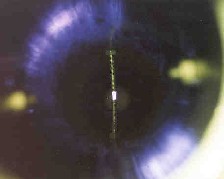

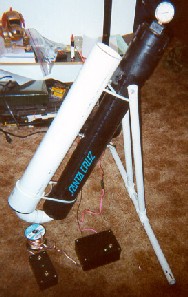
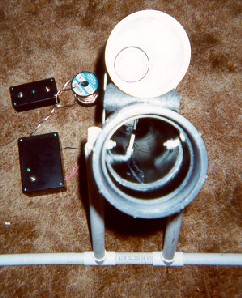
Gillian's TP Mortar is the top o' the line potato shooter. Here's the original schematic I drew up for it back in 2000 I think. Its base is a 4" diameter 3 foot combustion chamber. This shooter also has a 4" piston driven barrel. The piston (empty can of starkist tuna) allows us to launch anything that will fit down the barrel. Originally it was designed to launch rolls of toilet paper into orbit around Stanford, but due to the dry conditions there (fire hazard), a TP launch has never been attempted. We have launched a few pineapple tops and several spuds at the same time. At first we tried to restrain the tuna fish can piston with some wire. Then we tried a nylon strap and spring. Notice the permanent deformation of the spring. We have decided that restraining it at all is just not a good idea.
Originally the ignition system was a typical BBQ piezo electric grill lighter with 5 ft of wire leading to the shooter. After the first observance of its destructive power, it was quickly decided that a better ignition system must be made, one that allowed us to be FAR FAR away from the shooter. After some serious research on the subject and some scrounging through dumpsters for parts I created an ignition system allowing us to be 50 feet away (via a 50 ft cable) during detonation. The ignition system has gone through many upgrades and changes since it was first created. The most recent upgrade was using a radio control automobile remote/relay system. Now there is no cable, we just hook the ignitor to the cannon, get as far away as possible, and hit the "fire" button. Here's the photo:
The author assumes no liability for any incidental, consequential
or other liability from the use of this information. All risks and
damages, incidental or otherwise arising from the use or misuse of the information contained herein are entirely the responsibility of the user, have a nice day!
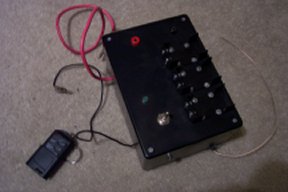
An inexpensive alternative would be to build your own radio controled switch from a cordless telephone. Need help? Check it out here
DISCLAIMER
Copyright 2003, Greg Miller
https://www.angelfire.com/80s/sixmhz/coolstuff.html